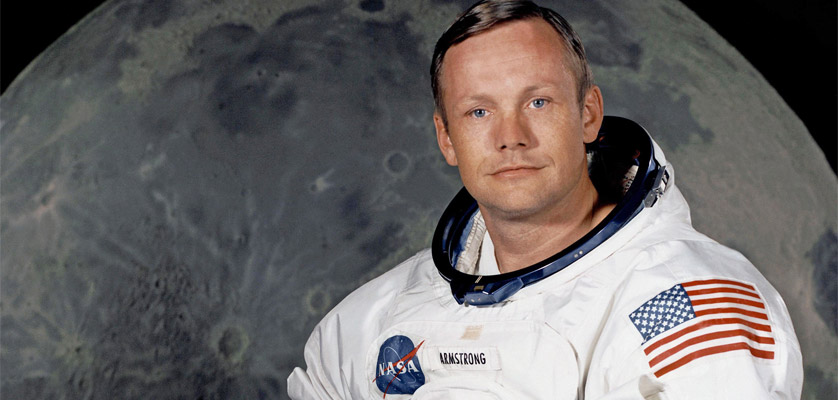Neil Armstrong: One Giant Leap for Mankind
This year marks the 50th anniversary of astronaut Neil Armstrong becoming the first man to walk on the moon. As the intrepid explorer alighted from the spacecraft, he uttered the legendary words: "That's one small step for a man, one giant leap for mankind."
It has become one of the most famous phrases in history, as more than half a billion TV viewers watched the American brave the unknown. Armstrong and his fellow astronaut, Buzz Aldrin, successfully walked across the moon's surface, collecting samples of materials to bring back to earth, on 21st July 1969.

© NASA
Historic moment
The Apollo 11 space flight (NASA's fifth manned mission on the programme) was launched from Florida's Kennedy Space Centre.
Armstrong, 38, stepped out of the spacecraft at 2.56am. Aldrin, 39, began his moon walk some 20 minutes later. The third astronaut on the mission, Michael Collins, 38, wasn't involved in the exploration. He piloted the command module, Columbia, while Armstrong and Aldrin completed their exploratory walk for more than two hours.
Between them, they collected 47.5 lbs of materials from the moon's surface to take back to earth. They took photographs, planted and saluted the United States' flag and left a commemorative plaque that read: "We came in peace for all mankind."
Apollo 11 arrived back on earth on 24th July 1969, landing in the ocean off the coast of Hawaii. All three crew members returned safely, having completed a daring mission which would go down in history.
<iframe width="100%" height="50%" src="https://www.youtube.com/embed/G6A72ufn3l4" frameborder="0" allow="accelerometer; autoplay; encrypted-media; gyroscope; picture-in-picture" allowfullscreen></iframe>
Apollo programme
NASA had gone to great lengths to make the space dream a reality. The whole Apollo programme cost an estimated $25.4 billion and the Apollo 11 spacecraft was a miracle of modern engineering.
Huge hydraulic lifts were required to hoist the rocket into a vertical position on the launch pad. This enabled final safety checks before the launch could take place.
Hydraulics play an important role in space exploration. A basic hydraulics system consists of the cylinder, the fluid and the pump. This powers various aspects of space exploration and travel, as research has found that hydraulic systems continue to work well, providing a number of vital functions for space vessels, including the thrust vector control for the engine, controlling the brakes and rudder and enabling control of various valves. They are also used to retract the external tanks, disconnect umbilical connections and to deploy the landing gear.
Fuel was used as a lubricant within the Apollo 11 engine and also as a hydraulic working fluid. In order to fire up the engine, the starter solenoid directed hydraulic pressure from the ground supply to open up the main valves.
Combustion-induced pressure to the injector plate operated the ignition monitor valve and directed hydraulic fluid to open the fuel valves. When the turbopump reached full speed, the fuel pressure exceeded the hydraulic pressure supplied from the ground, so the valves' switch was flicked to feed the engine's hydraulic supply directly from the rocket's fuel.
Docking methods
The Apollo 11 spacecraft had two docking hatches, one at the top of the cabin and a second in the nose of the vehicle. The astronauts had to crawl through a tunnel to go from the pressurised spacecraft to the landing vehicle.
The docking arrangement allowed the crew to enter the lunar exploration module through this hatch. It was more difficult to re-enter Apollo 11 from the landing craft, as the astronauts had only a limited view of the upper docking hatch. It was described by one of the developers as "not being able to see a garage as you drive into it".
Landing gear for the moon's surface was designed for various conditions including craters, depressions, slopes and a soil-type surface. To ensure it was stable, the landing gear needed to absorb a wide range of impact loads. This was achieved by ensuring the struts would compress on impact with the surface.
Following the moon landing, Armstrong gave an interview praising the "hundreds of thousands" of people who had made the successful mission possible, calling it the "beginning of a new age".
War heroes
Armstrong had worked hard to become the most famous astronaut in the world. Born in August 1930, he studied aeronautical engineering at Purdue University in his youth. A pilot in the Korean War, his Grumman F9F Panther was hit by anti-aircraft fire in 1951, but he managed to bail out successfully.
After the war, he was a test pilot for the National Advisory Committee for Aeronautics, flying many new planes for the US Air Force and then joining the "Man in Space Soonest" space flight programme. After joining NASA Astronaut Corps in 1962, his first space flight was as the commander of Gemini 8, in March 1966.
While training to join the crew of Apollo 11, he narrowly avoided a potentially fatal accident when he managed to eject from the Lunar Landing Research Vehicle seconds before it crashed and burst into flames.
Aldrin was also a war hero, having seen active duty in the Korean War as a second lieutenant in the United States Air Force. He flew 66 combat missions in the jet fighter F-86 Sabre. After the war, he worked as an aerial gunnery instructor and became flight commander of the 22nd Fighter Squadron.
He began training as a NASA astronaut in October 1963. While preparing to join the Apollo 11 crew, he set a record of two hours and 20 minutes for working outside a spacecraft.
Reluctant celebrity
Both Armstrong and Aldrin became international heroes after their famous moon walk, but Armstrong never liked the celebrity status and was what his family called a "reluctant hero". He was approached by various parties to enter politics, but refused, preferring to take an admin role in aeronautics at NASA's headquarters.
Following Armstrong's death, aged 82, in 2012, Aldrin described him as being "extraordinary in his talents". Aldrin, now 89, has forged a media career, appearing in cameo roles as himself in popular TV shows such as The Big Bang Theory and films including Transformers: Dark of the Moon.
Collins, now 88, became the US Assistant Secretary of State for Public Affairs in 1970, under President Richard Nixon. He was then director of the National Air and Space Museum. He has also run his own consulting firm, Michael Collins Associates, and has written several factual books about his life as an astronaut.
Conspiracy theories
Despite the much-publicised legendary moon landing, some people have stated that they don't believe it ever happened. Look on the internet and you'll find a multitude of moon landing conspiracy theories. Doubters have put forward all kinds of arguments during the past half-century.
It has been suggested that two huge belts of radiation around the earth, called the Van Allen belts, would have fried the crew and made them seriously ill, but the mission was timed to take place when the belts were at their lowest intensity. It took less than two hours for Apollo 11 to pass through their range, so the astronauts were exposed to just 18 rads of radiation, which was within the safety limit.
A common argument was that the flag appeared to "flap" on the moon's surface - and how could this be when there was no breeze? However, this has been disputed by NASA. They said a horizontal rod projected from the top of the flag pole to hold the flag unfurled. The astronauts had to rotate the flag back and forth to ensure it was properly dug into the lunar soil, so this made it ripple.
Critics have suggested the oddly-shaped shadows on the moon's surface could have been created by studio lights. Again, NASA has refuted this, stating they were caused by the sun being low in the sky, the moon's rough surface and the uneven ridges.
New scientific evidence
In recent years, modern scientific evidence has proved that people did indeed walk on the moon. A photo of the moon's surface, taken by the crew of Apollo 15 in 1971, perfectly matches a modern 3D image, taken by the Japanese lunar orbiter, Seline, in 2008.
The two images show the same terrain and scenery, captured on lunar missions 37 years apart and organised by two different countries' space agencies.
NASA’s Lunar Reconnaissance Orbiter has been orbiting around the Moon since 2009. Recently, it captured clear photographs of the Apollo landing sites, and even the astronauts' footprints. Other nations' space missions (Japan, China and India) have also independently spotted the Apollo 11 landing site.
As one of the UK's largest independent hydraulics companies, Phoenix Hydraulics provides specialist hydraulic services. We stock a market-leading selection of hydraulic pumps. Please give us a call on 01733 234800 for further information.


